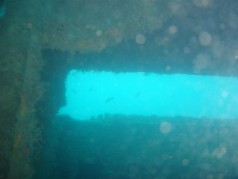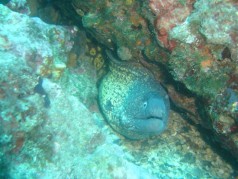| THE WRECK ''REGGIO MESSINA''
Deepest point -35 meters
After spending some years half wrecked in Barcelona's harbour, The Reggio Messina was towed to L'Estartit in 1991 and let sink at the same spot where it is today. This 130 meter long roll on roll of ferry, which used to carry trains to Italy, was purposely sank in 1992 it is now in three sections from 35 meters to 26.
When it came to be retired from service, a Catalan company bought the Reggio with the intention of converting it into a pleasure boat to be opened in time for the 1992 Olympic Games. To this end, scrapping works started on the deck where the trains were transported, and the ship“s engines were taken out. But the many holes caused by these operations left the ship defenceless when heavy rains fell at the end of the year and caused the ferry to sink right there in the wharf at Barcelona.
The ship was refloated, but due to the damage could not be used for commercial purposes, so the idea formed to tow it to Estartit and use it as an artificial reef positioned to attract divers from some of the heavily visited sites in the area. While being resunk it fell to the bottom where it lay in a bad position and, some time later, the force of easterly storms displaced it and broke it into three large pieces.
The hulk of the Reggio Messina lies alist on its port side, with the stern facing Punta del Castell.
The stern is the largest and best preserved part, as it remains white vertical on its keel, with the end pointing towards the nearby Punta del Castell. The stern section is 60-70 metres long and lies on the seabed at a depth of about 32 m, which is why exploring this fragment can be considered a complete dive itself. The rear section is in best condition offering the chance to penetrate the wreckage through many of its stairwells and missing hull section . The wreck is fast becoming a heaven for marine life.
Its huge rooms, its mast and its wrought iron give the place an eerie and imposing atmosphere, broken now and then by a shoal of sea bream, mackerel, sargus and the familiar lobster.
The middle piece (between 20 and 30 metres long) is particularly damaged with its upper part torn off and completely displaced to portside, now resting on the bottom. Exploring this part of the ship with poor visibility can be chaotic and one has the feeling of crossing an untidy mass of underwater junk. Among the sheets around the deck numerous lobsters have adopted the Reggio as their home
The prow is also damaged quite badly and very lopsided. This section is over 20 metres long, with a considerable layer of sediments (sometimes more than 10cm thick) covering most of the structure.
The main deck, where the remnants of the old railway tracks can still be seen, it at a depth of 28m. Above the deck the stern mast rises 16-17m.
|
| |


